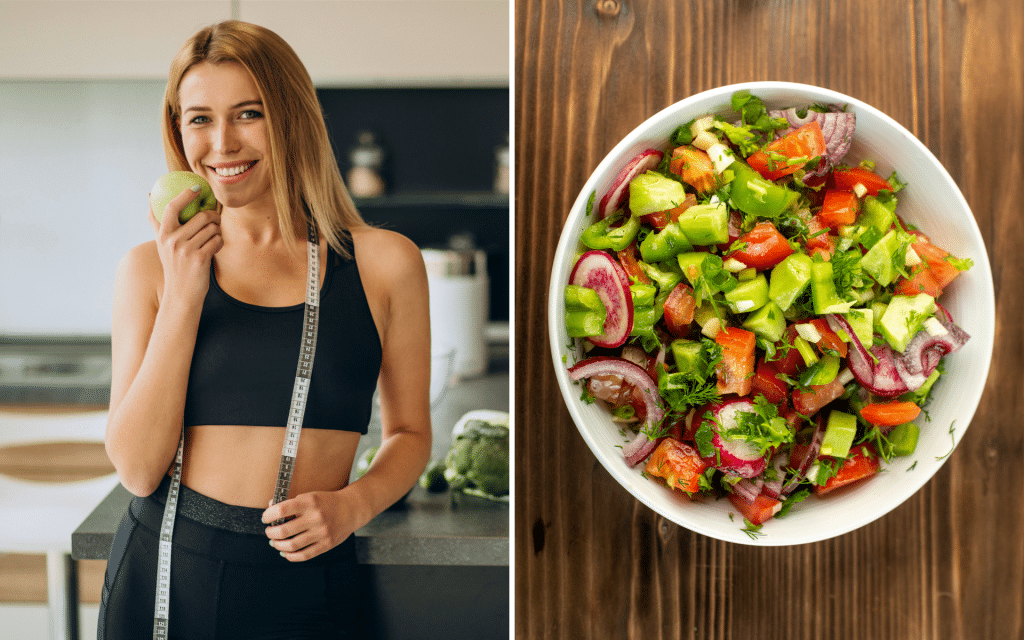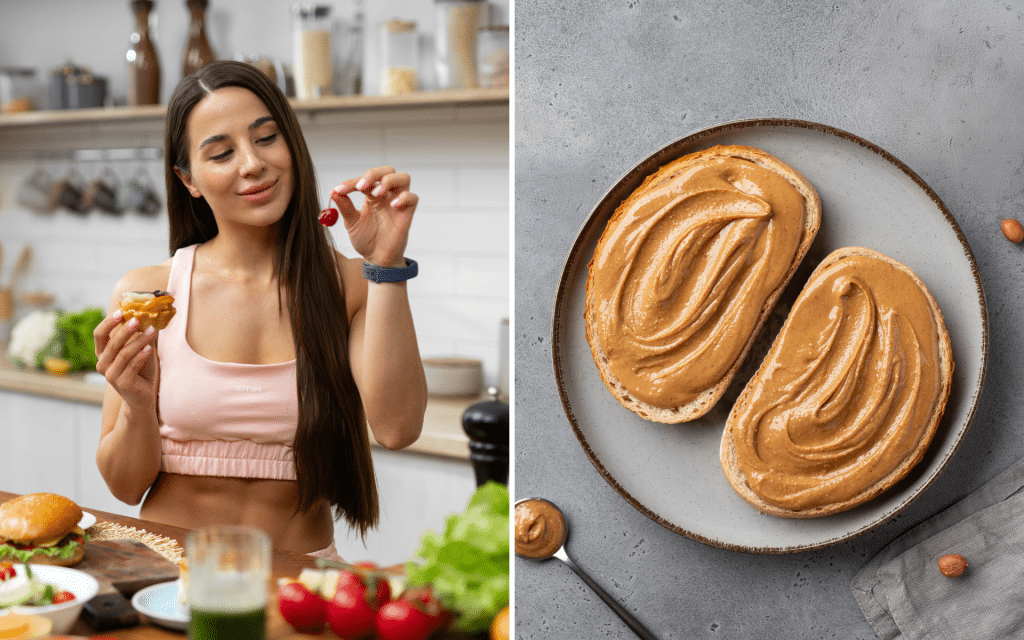There are many lunch ideas for the elderly: tasteful and healthy meals for seniors that spice up any day. Creating a 7-day meal plan for elderly with the following recipes is easy and fun as the list of meals is broad enough and it doesn’t require fancy cooking skills.
Such easy lunch recipes help seniors stay invigorated, stronger, and satiated for longer.
In addition, you shouldn’t be afraid of making substitutions or tweaking any dish a little. You’re the chef and only your food preferences are essential.
Delicious, filling, and flavoursome meals add a special atmosphere to your daily routine. Even those individuals who dislike cooking can change their minds as they’re going to spoil themselves with something personally good.
Let’s get into the recipes.
What Are Some Lunch Ideas for the Elderly?
Regarding simple lunch ideas for elderly people, we need to understand that vitamins and minerals at this age are particularly important for daily performance. As we age, our muscle mass declines, our brains may not feel as sharp as before, and our risk of certain chronic diseases increases.
A nutrient-dense diet in this case may not be a miracle cure, but it can surely increase your chances of staying healthier.
These easy meals for seniors to prepare will perfectly satisfy their needs and fill their bodies with essential components.
Chicken Caesar Wrap Recipe
Ingredients:
- 1 rotisserie chicken, meat removed and shredded
- 4 large flour tortillas
- 2 heads romaine lettuce, chopped
- 1/2 cup shaved parmesan cheese
- 2 cups prepared Caesar salad dressing
- 1 cup cherry tomatoes, halved
- 1/2 cup whole-grain croutons
Preparation process:
- Mix the chicken and salad dressing until well combined In a medium-sized mixing bowl.
- Lay out a tortilla, then layer 1/4 of the chopped lettuce, 1/4 of the chicken, 1/4 of the tomatoes, 1/4 of the cheese, and 1/4 of the croutons. Wrap the tortilla and enjoy.
Nutritional value per serving (1 wrap) (makes 4)
| Calories | Fats | Protein | Fiber | Carbs |
|---|---|---|---|---|
| 1133 | 86g | 43g | 9g | 48g |
Caribbean Chicken Salad Recipe
Ingredients:
- 150g easy-cook long-grain white rice
- 25g sultanas
- 2 bananas, sliced
- 250g cooked chicken, chopped
- 150g pineapple pieces in natural juice, drained
- 100g red or green seedless grapes
- 4 tablespoons low-fat natural yogurt
- 1 tablespoon lemon juice
- 1 pinch ground black pepper
- 1 teaspoon reduced-fat mayonnaise
- 1 handful lettuce leaves, shredded
Preparation process:
- Cook the rice in a saucepan according to the package’s instructions, until tender. Drain and rinse under cold water to cool quickly, then drain again.
- Mix the rice, bananas, pineapple, grapes, sultanas or raisins, and lemon juice.
- Mix the yogurt and mayonnaise in a large bowl. Add the rice mixture and chicken. Season with pepper and mix the ingredients.
- Arrange the lettuce on 4 serving plates and share the chicken mixture between them. Serve immediately.
Nutritional value per serving (serves 4)
| Calories | Fats | Protein | Fiber | Carbs |
|---|---|---|---|---|
| 349 | 4.8g | 25.5g | 3.4g | 49.4g (2) |
The BetterMe: Health Coaching app will provide you with a host of fat-frying fitness routines that’ll scare the extra pounds away and turn your body into a masterpiece! Get your life moving in the right direction with BetterMe!
Easy Carrot Soup
Ingredients:
- 1 large chopped onion
- 8 washed and chopped carrots (about 500g)
- 1.2 litres of reduced-salt vegetable stock
- 100g lower-fat soft cheese
- 1 pinch ground black pepper
- small bunch of fresh coriander, chopped
Preparation process:
- Put the onion and carrots into a large saucepan and bring to a boil.
- Reduce the heat and simmer for 20 to 25 minutes.
- Blend the soup to a purée using a blender or a food processor. Blend until smooth. Add most of the soft cheese and blend again.
- Reheat gently and serve garnished with the remaining cheese and optional ingredients.
- Enjoy with a slice of wholemeal bread.
Nutritional value per serving (serves 4)
| Calories | Fats | Protein | Fiber | Carbs |
|---|---|---|---|---|
| 100 | 2.1g | 4.6g | 4.9g | 13.2g (3) |
Read more: Intermittent Fasting for Women Over 70: Is It a Safe Option for Weight Loss?
What Is a Good Meal for an Elderly Person?
Among easy meals for seniors to prepare, healthy bowls are the real winners as they can combine lots of ingredients and you can easily make substitutions according to your taste.
This healthy recipe for a Mediterranean Quinoa Bowl can help you satisfy your hunger needs and fill your body with a nutrient combo.
The Mediterranean diet is linked to reduced risk of heart disease and decreased risk of mortality (4), so adding it to your diet could be beneficial for your health.
Recipe for the Bowl
Ingredients:
- 1 15 oz can chickpeas, drained, rinsed and patted dry
- 1 teaspoon olive oil
- ½ teaspoon oregano
- ½ teaspoon salt
- 1 teaspoon lemon juice
- ¼ teaspoon pepper
- 4 cups baby spinach or arugula, loosely packed
- 1 cup cherry chopped tomatoes
- 1 cup chopped cucumber
- ½ cup red onion, chopped
- ½ cup feta cheese, crumbled
- ¼ cups kalamata olives
- Lemon vinaigrette
- Fresh parsley, for serving
- Hummus, for serving
How to prepare:
- Preheat the oven to 400°F and line a baking sheet with parchment paper.
- Boil quinoa in a saucepan. Reduce to a simmer, cover, and cook for 15 minutes. Fluff with a fork and allow to cool for 5-10 minutes.
- Add the chickpeas to a mixing bowl with oil and seasonings. Pour the chickpeas onto a baking sheet and bake for 20 minutes, flipping halfway. Once cooked, set aside to cool.
- Make the bowl by adding ½ cup cooked quinoa, 1 cup greens, ¼ cup cucumber, 2 tablespoons feta cheese, ¼ cup tomatoes, 1 tablespoon kalamata olives, 2 tablespoons onion, and a scoop of hummus to 4 bowls.
- Divide the chickpeas evenly and add to the bowls, then drizzle with dressing.
- Serve immediately.
Nutritional value per bowl (serves 4)
| Calories | Fats | Protein | Fiber | Carbs |
|---|---|---|---|---|
| 579 | 32g | 18g | 10g | 54g (5) |
What Are 5 Foods that Seniors Should Eat?
There are main food groups that seniors should pay attention to and often add to their meal plans for seniors at home (6).
- Vegetables
There are lots of vegetables that come in many shapes, colors, and textures. Vegetables contain lots of vitamins and minerals and are an excellent source of fiber. Seniors should aim to add more dark green vegetables, such as spinach, broccoli, and kale; red and orange vegetables, such as carrots, pumpkin, tomatoes, and sweet potatoes; starchy vegetables, such as corn, green peas, and white potatoes; and legumes such as black beans, tofu, and kidney beans to their diets.
- Fruits
Fruits are also excellent sources of fiber that help promote your digestive system. As with vegetables, they provide a variety of vitamins, minerals, and beneficial phytonutrients. Great options include kiwis, bananas, apples, apricots, mangoes, and pineapples.
- Whole Grains
Any food that is made from rye, wheat, rice, oats, cornmeal, barley, or other cereal grain is a grain product. Grains contain carbohydrates, the body’s main source of energy. Whole grains provide iron and many B vitamins, in addition to fiber.
- Protein Foods
Protein is used to build and repair tissues, including muscle. Many sources of protein allow you to enjoy a range of meals. You can get protein from eggs, lean meat, seafood, nuts, seeds, pulses, and soy products.
Protein is especially good for older adults as it is helpful for maintaining muscle mass, which is important for mobility and overall quality of life as we age.
- Dairy
Dairy helps seniors maintain strong bones and provides several nutrients, including calcium, vitamin D, and potassium. Add cottage cheese, low-fat milk, cheese, and Greek Yogurt to your recipes. People with lactose intolerance may need to avoid dairy, but can look for plant-based alternatives that are fortified with calcium and vitamin D.
What to Make for Lunch for the Elderly
Easy meals for the week for elderly people should include whole grains, vegetables, and lean meats or vegan-friendly alternatives. It’s essential to use foods from the aforementioned five-group list: fruits, vegetables, whole grains, dairy, and protein products.
Other foods that can spruce up your lunchtime include oils and healthy fats. Great examples are avocados, fish, and vegetable oils (6).
Lunch ideas for the elderly can be different, from wraps to cream soups that are easier to prepare than you may think.
BetterMe: Health Coaching app helps you achieve your body goals with ease and efficiency by helping to choose proper meal plans and effective workouts. Start using our app and you will see good results in a short time.
What Is the Best Lunch for the Elderly?
The best lunch for the elderly is easy to prepare and healthy. Among the easy meals for elderly people to make, this one is a winner – it only takes 10 minutes.
Quick Chicken Couscous Recipe
Ingredients:
- 200g couscous
- 1/4 chopped cucumber
- 250g skinless, boneless roast chicken breasts, chopped
- 450ml reduced-salt chicken or vegetable stock
- 100g sweetcorn
- 2 chopped tomatoes
- 1 pinch ground black pepper
- 1 tablespoon lemon juice
Instructions:
- Place the couscous into a large mixing bowl and cover with the hot stock. Leave for 10 to 15 minutes and stir to fluff the grains.
- Add the chicken, tomatoes, sweetcorn, cucumber, lemon juice, and black pepper.
- Stir all the ingredients and divide between 4 bowls.
Nutritional value per serving (serves 4)
| Calories | Fats | Protein | Fiber | Carbs |
|---|---|---|---|---|
| 322 | 4.2g | 26.8g | 3.3g | 42.8g (7) |
Read more: The All-Inclusive Guide to Intermittent Fasting for Women Over 65
What Is a Healthy Lunch Meal for Elderly People?
How about soft meals for the elderly? Like many other people, seniors enjoy something aside from solid food. Softer foods are easier to chew and swallow, which may be important for some older adults. These home recipes for creamy soup can enlighten your day with a tender texture and fulfilling aroma.
Chunky Chicken and Sweetcorn Soup
Ingredients:
- 100g cooked chicken, chopped
- 1 small onion, finely chopped
- 250g potatoes, scrubbed and chopped into small chunks
- 15g lower-fat spread
- 100g sweetcorn (fresh or tinned)
- 1 pinch ground black pepper
- 600ml reduced-salt vegetable stock
- 300ml semi-skimmed milk
- 2 tablespoons cornflour, mixed with 2 tablespoons cold water
- 2 tablespoons fresh chopped parsley
Method:
- Melt the spread in a large saucepan, add the onion, and cook for 2 to 3 minutes, until it starts to soften.
- Add the potatoes and stock. Bring to a boil for a few seconds, then turn down the heat and simmer for approximately 20 minutes. The potatoes should become tender.
- Add the sweetcorn, milk, and chicken, and cook gently for 4 or 5 minutes, stirring often.
- Add the cornflour mixture and stir until it thickens. Add the parsley and cook for another few minutes.
- Ladle into bowls and serve with whole-grain bread or rolls.
Nutritional value per serving (serves 4)
Cream of Pumpkin Soup
Ingredients:
- 1 cup chopped onion
- 2 (14.5-ounce) cans of chicken broth
- 1 (15-ounce) can of pumpkin puree
- 2 tablespoons butter, melted
- ¼ teaspoon ground cinnamon
- ⅛ teaspoon ground ginger
- 1 teaspoon salt
- 1 cup heavy whipping cream
- ⅛ teaspoon ground black pepper
- Chicken broth
Method:
- Saute the onion in butter or plant oil in a medium saucepan until tender. Add 1 can of chicken broth and stir well. Bring to a boil, reduce the heat, and simmer for 15 minutes.
- Transfer the broth mixture to the food processor. Process until smooth.
- Return mixture to saucepan. Add the remaining can of broth, salt, pumpkin, ground ginger, ground cinnamon, and ground pepper. Stir well.
- Bring to a boil. Reduce the heat and simmer for 10 minutes more, stirring occasionally.
- Stir in the whipping cream and heat through, but don’t boil.
- Ladle into individual soup bowls.
Nutritional value per serving (serves 6)
Definitions vary by region, context, culture, and individual perception. However, in many contexts, a person who is 65 years or older is considered to be elderly. This will depend on each individual. However, as people age, their metabolic rate decreases, which can lead to a reduction in appetite. Sometimes chewing and swallowing difficulties can also result in an older person eating less. Recommended food for the elderly that is easier to swallow includes oatmeal or other hot cereals, pancakes, soups, mashed potatoes, soft braised meat, well-cooked vegetables with sauce, yogurt, cottage cheese, pudding, and scrambled eggs. Great snacks for aged care include hard-boiled eggs, Greek yogurt with berries, baked sweet potato chips, oatmeal, fruits, sandwiches with hummus and tomatoes, nuts, and seeds, jerky, and trail mix. Frequently Asked Questions
What age is considered elderly?
Do seniors eat less food?
What foods are easy to swallow for elderly people?
What are good snacks for aged care?
The Bottom Line
This review has covered some helpful lunch ideas for elderly people: tasteful and healthy meals for seniors. To stay stronger and healthier, seniors need to fill up their plates with 5 main groups of foods: whole grains, vegetables, fruits, protein products, and dairy.
Fatty fish and other healthy oils should also become a part of their weekly eating plans as beneficial sources of omega-3 and other healthy fats.
DISCLAIMER:
This article is intended for general informational purposes only and does not serve to address individual circumstances. It is not a substitute for professional advice or help and should not be relied on for making any kind of decision-making. Any action taken as a direct or indirect result of the information in this article is entirely at your own risk and is your sole responsibility.
BetterMe, its content staff, and its medical advisors accept no responsibility for inaccuracies, errors, misstatements, inconsistencies, or omissions and specifically disclaim any liability, loss or risk, personal, professional or otherwise, which may be incurred as a consequence, directly or indirectly, of the use and/or application of any content.
You should always seek the advice of your physician or other qualified health provider with any questions you may have regarding a medical condition or your specific situation. Never disregard professional medical advice or delay seeking it because of BetterMe content. If you suspect or think you may have a medical emergency, call your doctor.
SOURCES:
- Easy Chicken Caesar Wrap Recipe (2020, wholefully.com)
- Caribbean chicken salad recipe (n.d., nhs.uk)
- Easy carrot soup recipe (n.d., nhs.uk)
- Mediterranean Diet in Older Adults: Cardiovascular Outcomes and Mortality from Observational and Interventional Studies—A Systematic Review and Meta-Analysis (2024, mdpi.com)
- Mediterranean Quinoa Bowl (2025, eatingbirdfood.com)
- Healthy Eating As You Age: Know Your Food Groups (2022, nia.nih.gov)
- Quick chicken couscous recipe (n.d., nhs.uk)
- Chunky chicken and sweetcorn soup recipe (n.d., nhs.uk)
- Cream of Pumpkin Soup (2022, allrecipes.com)









